#ecosystem
Explore tagged Tumblr posts
Text
The Permaculture Spiral Garden - A Great Starting Point
There is probably no other structure as popular for illustrating Permaculture in practice as the Herb Spiral. Okay, I guess I could mention the lasagna sheetmulching method or also the cob oven that tends to be the first hands-on project at a typical Permie intro session. But when it comes to showing how landscape design, zones and sectors, stacking functions, and efficient use of space and water come together in one unique structure, the Spiral Garden is unbeatable.
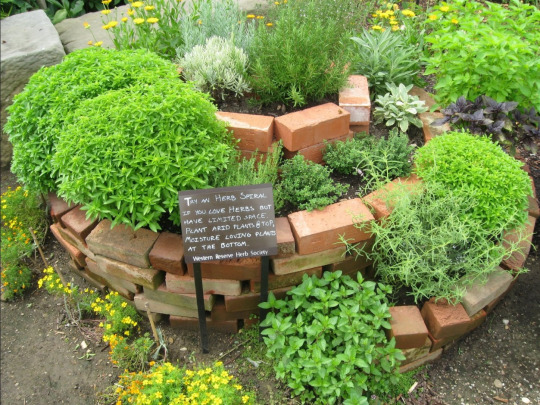
Turning Theory into Practice
In typical Permaculture Designer Certificate courses, but even in brief intro weekends to Permaculture, there tends to be a lot of theoretical discussions. Since the numerous design principles can be applied to any climatic region, from the tropical to the subarctic, and on any scale from the humongous to the tiny, the practical aspects of the ideas can easily get lost. That's where a good hands-on application comes, where the participants get to move around rocks and dirt, while realizing how much it ties in to the concepts they've just discussed. This way the apparent "main purpose" of "building something to grow all your kitchen herbs on", becomes a neat side feature.
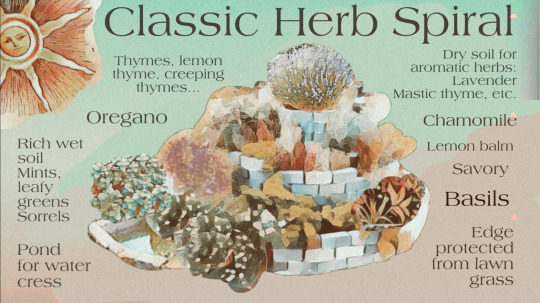
Adjust Your Landscape!
The first thing to realize that landscape is welcome to be modified and adjusted to bring out the best in it. Clearly, while it is important to work with what's there already, it doesn't hurt think about mounds and valleys. And before you bring out the excavators for your large-scale farm, it makes sense to start small… say on a circle of 2-5 meters (6-16 feet) diameter. In other words, the Spiral Garden is a hill with a spiral shaped surface, leading down to ground level, or further down into a water hole. It can be made out of rocks, bricks, concrete debris, or anything else you have lying around that can hold your soil.
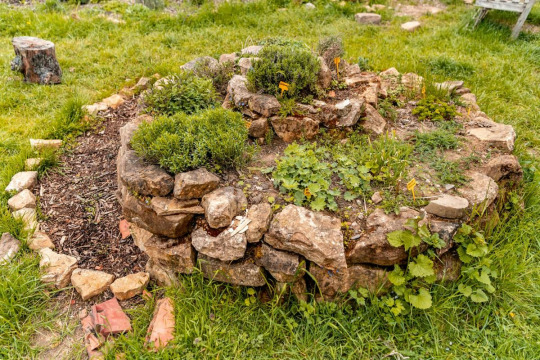
Design According to Your Scale
Looking around for existing Herb Spirals it's easy to get confused. Some are so big you can actually climb on them (that is, you have to in order to reach what's growing on top). Others are so tiny that you may not even want to step on them. The question is: which size is the right one for you? Since this is something you will have to decide almost daily in Permaculture, it doesn't hurt starting out with this important question.

Organizing Your Spiral Garden
While there are seemingly endless types of Spiral Gardens, there are a few things they all have in common: They all start out with a region on the top, where water is bound to run off right away, leaving the soil relatively dry. This area is also the most exposed to the wind. Keep this in mind when choosing the plants that are going to live here. Ideally, the spiral should start sloping toward the East from here. Delicate plants that benefit greatly from the morning sun will appreciate this region. As the slope continues toward the South and West, it becomes more suitable for sun loving species. Finally, as the spiral reaches the ground level in the shady Northern part, it will be perfect for herbs that prefer less sun, more shade and more water, since the soil tends to be wetter here. (Note: This is for the Northern Hemisphere. In the Southern Hemisphere North and South are reversed.) To make full use of the runoff water, many people add a small pond at the base of the spiral, where additional aquatic plants, such as watercress, can be grown.
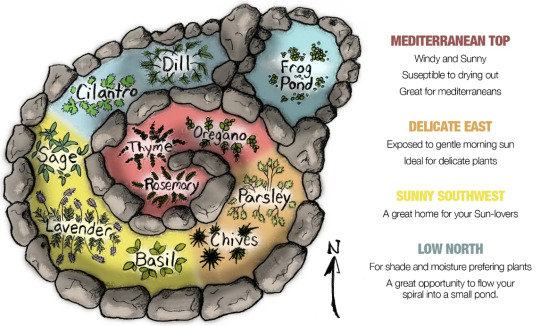
The given illustration offers a good number of herbs for a nicely diverse kitchen. Depending on what else you want in your Herb Spiral, you can add it in the most suitable region. Mint and lemon balm love the cooler, shady part with more water. Lemongrass is great in the sunny area, and tarragon and estragon prefer the dry top of the spiral. Of course, the idea is not limited to kitchen herbs. For maximalists, the same theory can work with a mountain you might want to terraform into a spiral farm. But right now I'd prefer to stay small scale.
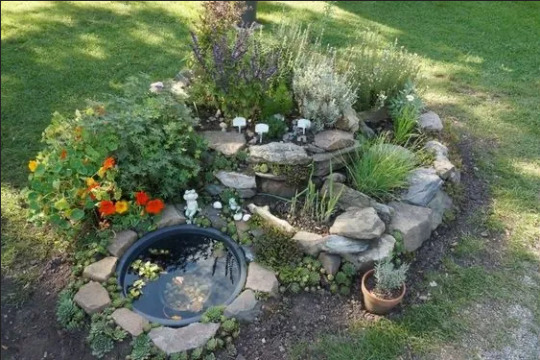
Plenty of Benefits (That's Why It's Permaculture)
As explained above, the main purpose of the Spiral Garden is not only to increase your gardening area by making use of the vertical, but also to create diverse climatic conditions, which do make a difference on the smallest scale. But as Permaculture tends to be, there are many other benefits to it. The structure itself offers great habitat for numerous animals, such as frogs, salamanders, lizards, but also pollinating insects, and of course others that may not directly benefit us, but by feeding on others they all add to the stability of our ecosystem. The structure itself will suppress weeds and make use of material that you're not likely to use elsewhere. Finally, depending on the size and location, it will be an ideal place to grow all your kitchen herbs right where you can access them most easily.
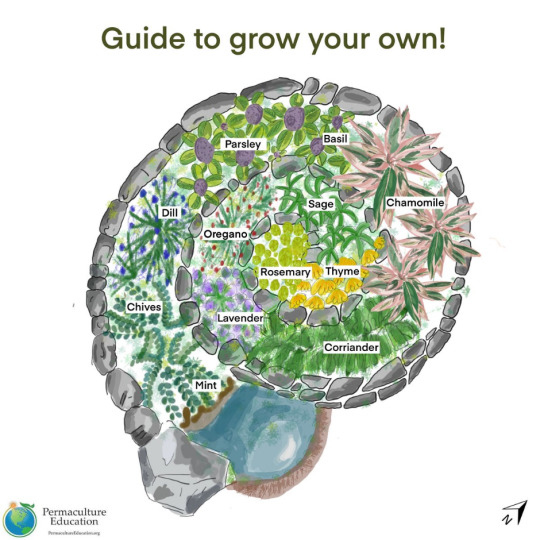
Some Things to Keep in Mind
When building the structure, make sure it will contain the soil in a nice trough, slanting slightly inward. That way bits and pieces that fall off will roll towards the center, until contained by the main mound.
Make sure the slope is always nice and gradual, avoiding sudden drops where the water can rush down quickly, eroding the soil.
If you're going to walk on your spiral, include a separate walkway that won't compress good soil. Most importantly, it should be sturdy enough to provide stability and make access safe.
Don't forget that while the structure is important to keep the soil in place, it is the soil that you'll be growing plants in. So it should have a good depth of 20-50 cm (8-20 inches) throughout the entire spiral. This can be the trickiest part!
Apply your own observation to which plants do better in which parts of the spiral. Also, with time you will find many other plants growing in it that you didn't plant. Before removing them, consider how much they actually bother your herbs, and whether their benefits may not outweigh their drawbacks.
Go Out and Build Your Own!
I hope this brief overview got you inspired to go out and try building an Herb Spiral yourself! I would love to hear your experiences with it!
Sources: 1, 2, 3, 4
3K notes
·
View notes
Text
ah yes, the ecosystem of the world and humans are a part of it
Dandelions have a symbiotic relationship with little kids who make wishes
#I love it when ppl find it weird#I think it's beautiful#Little kids need to have a dream in order for a species of flowers to survive#(not entirely true since plants would probably still do pretty well without us but you know I just wanted to be a lil poetic)#text#ecosystem#nautre
116K notes
·
View notes
Photo

The Fish That Climbed a Mountain
"These fish had been conscripted to serve as paratroopers in the state’s first attack, dropped behind enemy lines."
Who controls what is put into the lakes of America?
Alex Brown's new Longreads essay is the wild tale of a tiny fishing club's battle with the feds over alien trout.
Ready for a fantastic fish story? Read it here.
#fish#fishing#trout#nationalpark#north cascades#national park#park ranger#government#wildlife#ecosystem#environment#washington#recreation#sport#writing#nonfiction#essays#longreads
36 notes
·
View notes
Text
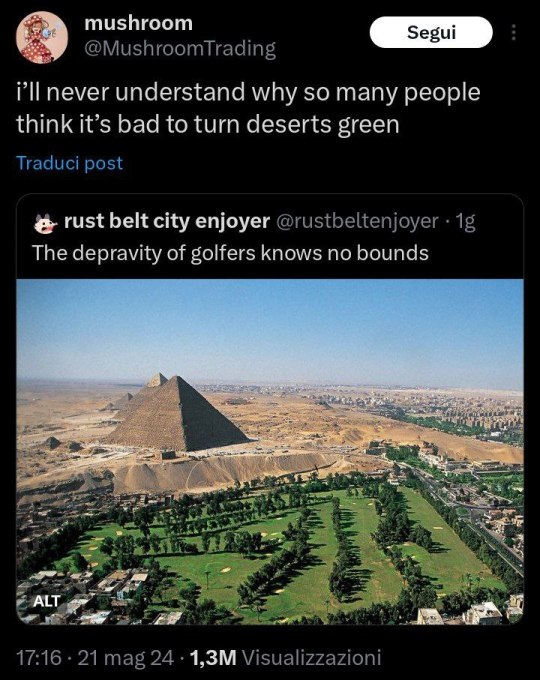
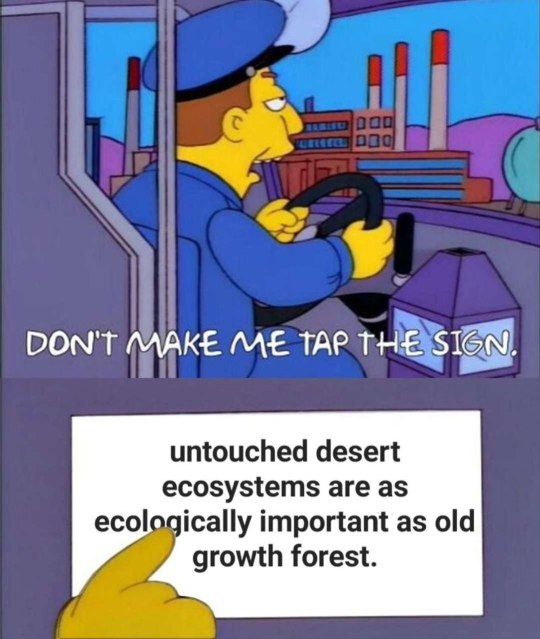
#deserts#desert#ecosystem#earth#ecology#econotego#golf course#golf equipment#golfers#mini golf#golf#ausgov#politas#auspol#tasgov#taspol#australia#fuck neoliberals#neoliberal capitalism#anthony albanese#albanese government#anti capitalism#capitalism#environmental activism#environmental#environment#enviroment art#environmetalists#enviromental#anti capitalist
103K notes
·
View notes
Text
"A tribal-led nonprofit is creating a network of native bison ranchers that are restoring ecosystems on the Great Plains, restoring native ranchers’ connections with their ancestral land, and restoring the native diet that their ancestors relied on.
Called the Tanka Fund, they coordinate donors and partners to help ranchers secure grazing land access, funds needed to install and repair fencing, increase their herd sizes, and access markets for bison meat across the country.
That’s the human part of the story. But as Dawn Sherman, executive director of the Tanka Fund, told Native Sun News, they’re “buffalo people” and these four-legged, 2,000 lbs. “cousins” are equal-part-protagonists.
The return of the bison means the return of the prairie, one of the three great grassland ecosystems on the planet, of which just 1% remains as it was when the Mayflower arrived.
“Bringing buffalo back to their ancestral homelands is essential to restoring the ecosystem. We know that the buffalo is a keystone species,” said Dawn Sherman, a member of the Lakota, Delaware, Shawnee, and Cree.
“Bringing the buffalo back to the land and to our people, helps restore the ecosystem and everything it supports from the animals to the plants to the people. It’s come full circle. That’s how we see it.”
As Sherman and the Tanka Fund help native ranchers grow their operations, everyone is well aware of the power of the bison to transform the environment: just as nations across Europe are, who are reintroducing wood bison to various ecosystems, for all the same reasons.
Sherman points out the variety of ways in which buffalo anchor the prairie ecosystem. The almost-extinct black-footed ferret, she points out, lived symbiotically with the bison, and with the latter gone, the former followed—nearly.
The long-billed curlew uses bison dung as a disguise to hide nests from predators. Deer, pronghorn antelope, and elk all rely on bison to plow through deep snows and uncover the grasses that these smaller animals can’t reach.
Everywhere the bison hurls its massive body, life springs in the beast’s wake. When bison roll about on the plains, it creates depressions known as wallows. These fill with rainwater and create enormous puddles where amphibians and insects thrive and reproduce. Certain plants evolved to grow in the wet conditions of the wallows which Native Americans harvested for food and medicine.
Native plants evolved under the trampling hooves of millions of bison, and that constant tamping down of the Earth is a key necessity in the spreading of native wildflower seed.
Indeed, Sherman says some of these native ranchers are bringing bison onto lands still visibly affected by the Dust Bowl, and already the animals are acting like a giant wooly cure-all for the land’s ills.
Since 2020, the Tanka Fund, in partnership with the Inter-Tribal Buffalo Council and the Nature Conservancy, has overseen the transfer of 2,300 bison from Nature Conservancy reserves to lands managed by ranchers within the Tanka Fund network.
“[T]he more animals that we can get the more of that prairie we can restore,” said Sherman. “We can help restore the land that has been plowed and has been leased out to cattle ranchers.”"
youtube
-Article via Good News Network, February 13, 2025. Video via Tanka Fund, July 17, 2024.
#indigenous#indigenous peoples#first nations#native americans#bison#ecology#ecosystem#ecosystem restoration#keystone species#endangered species#environment#prairie#great plains#land back#good news#hope#Youtube
15K notes
·
View notes
Text
i have a sneaking suspicion this may be true of land animal migration too.
Whale Migration Carries Nutrients

When it comes to the movement of nutrients in the ocean, we think of run-off from rivers, upwelling along coasts, and convective currents. We don’t typically think about animal migrations, but a new study of baleen whales (including species like humpbacks and right whales) suggests that these massive mammals provide a small but critical spreading service. (Image credit: C. Le Duc; research credit: J. Roman et al.; via Eos) Read the full article
#fluid dynamics#biology#nutrient transport#physics#science#whales#whale migration#ecosystem#marine biology
68 notes
·
View notes
Text
There is so much we don't understand. Springtime, out in the meadow. Everybody all over the dandelions--- flies, ants, tiny bees, even tinier bees so minuscule they're like black and jewel-colored particles without a closer look.
Get down on hands and knees--- you start to see the world. The tiny bees, a glittering blue-green color, slide down between the pollen-coated anthers of the dandelions into the crevices of the petals like miners sliding down into narrow shafts. The big bees make it look so simple. For the tiniest bees, a dandelion is a place more than it is a food. The bee's body is sleek like a suit of armor, and solidly shiny blue-green instead of having the distinctive stripes of many other bees.
Can I learn the name of this bee? To see the bee and to know it, you have to look very silly lying on the ground among the dandelions, looking closely at the things too small to be important. It is a mere particle, just a Bug, rather than a stereotypical fluffy yellow and black bee. It is complex and beautiful; its metallic and glittering exoskeleton, its transparent wings, its articulated and sensitive antennae.
"We have to save the bees, they are important," people say, but if we don't look closely, who is to say what is a bee and what isn't? And when we do look closely, isn't everything important?
871 notes
·
View notes
Text
European bison released in England’s ancient woodland have doubled in number since 2022, and the woodland has gotten healthier since, reviving previously extinct beetle species and increasing sightings of dormice and reptiles. And England isn’t the only European nation getting bison back in business: In the 1920s, there were just 54 European bison after intense hunting over millennia, but thanks to re-wilding efforts there are now around 10,000, mostly in Russia and Belarus. RTBC
#bison#europe#european bison#tatanka#good news#environmentalism#science#environment#nature#animals#conservation#rejuvenation#biodiversity#britain#united kingdom#buffalo#endangered species#ecosystem engineers#ecosystems#ecology#ecosystem#trophic cascades#rewilding#england#russia#belarus
918 notes
·
View notes
Text
From the article:
The new law aims to restore at least 20% of the EU's land and seas, with specific targets including reversing the decline of pollinators and restoring 25,000 kilometres of rivers to free-flowing conditions. This target is instrumental to align EU policy with global commitments made by almost 200 countries to restore and protect at least 30% of our planet’s degraded ecosystems by 2030. The legislation solidifies Europe's leadership in global biodiversity restoration and protection efforts, setting a powerful example for the rest of the world.
This law is in many ways the first of its kind and creates legally binding restoration targets for various ecosystems throughout the EU.
#nature restoration#EU#politics#good news#habitat#habitat restoration#ecosystem#ecosystem restoration#ecosystem conservation#conservation#habitat conservation#hope#hopepunk#climate change#environment#endangered species#biodiversity
940 notes
·
View notes
Text

#wildlife#wildlife conservation#ecosystem#wild animals#nature#solarpunk#solar punk#road safety#animal rights#animals#give a fuck#protect animals#Bridge#preservation#forests#forestcore
522 notes
·
View notes
Text
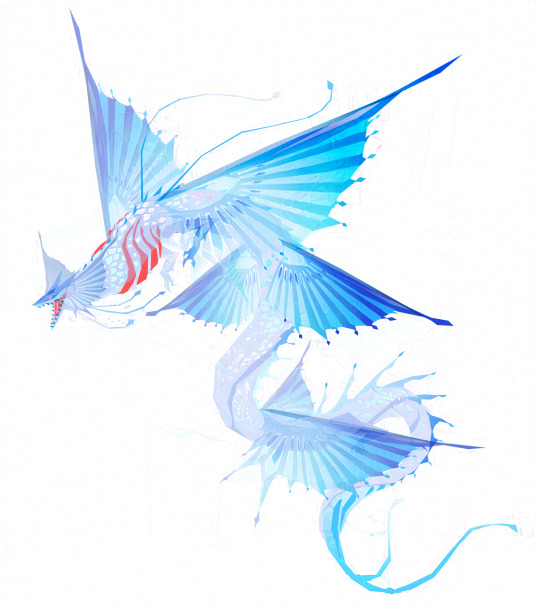
Commission for @irazel ! Really love how this one came out! Was very fun to design a flying fish/shark inspired dragon 🐉🌊🐟 (not to mention dragons are my favourite!)
#digital art#digital illustration#creature#aesthetic#art#creature design#concept art#fantasy creature#fantasy#artwork#art commissions open#monster#speculative biology#speculative evolution#ecosystem#concept design#animal#original art#original creature#nature#dragon art#dragon#wyvern#leviathan#sea serpent#sea dragon#marine life#aquatic#flying fish#ocean
2K notes
·
View notes
Text

Jungle pond..
374 notes
·
View notes
Note
How about the Port Jackson and its adorable smile! I think more people should know about it!
Love your blog! 🦈💖
Thank you so much!
Port Jackson Shark // Heterodontus portusjacksoni

These cute sharks grow to be approximately 1.65 m (5.4 ft) and are found exclusively in the waters of southern Australia. The conservation status for these sharks is unknown, but their eggs have a high mortality rate (only about 11-22% survive) because of high predation.

Unlike a lot of sharks, the Port Jackson shark doesn't have a mouthful of sharp, pointy teeth. They have a front row of small, pointed teeth that lead to wide, flat teeth in the back. These teeth are handy for catching and then breaking the shells of mollusks and crustaceans.

#animal facts#wildlife#biology#marine life#ocean#science#animals#marine ecology#marine biology#fun facts#shark#sharks#sea creatures#fish#marine animals#port jackson shark#fishes#aquatic life#fishblr#environment#ecosystem#ecology#environmentalism#oceans#sea#sea animals#gif#animal gifs
852 notes
·
View notes
Text
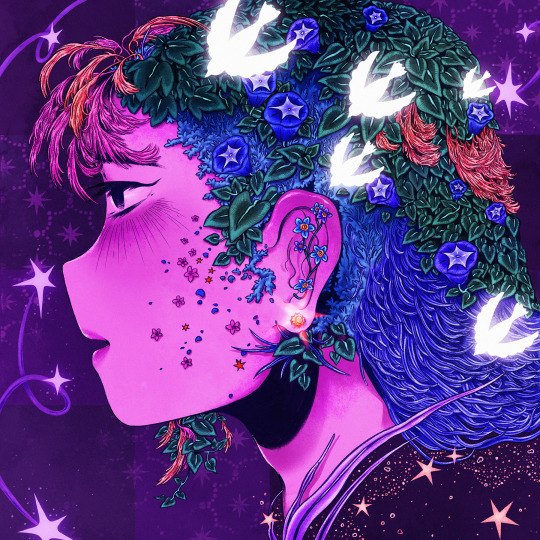
✷ purest thoughts ✷
if this resonates with you, feel free to support this lil creacher living paycheck to paycheck! ► my ko-fi page ☕️
#illustration#aesthetic#plants#magic#esoteric#ecosystem#blue#pink#morning glory#stars#forget me not#flowers#magical#mental health#hey!! its been awhile. i hope you've been well <3#art ph#portfolio#art fart#prinsomnia#being an adult is hard. i miss the simpler days when i was younger when i was able to not worry so much abt my bills and surviving and just#keep drawing#i still have so much to figure out but i'll keep going#life has become kinder to me despite the hardships and i'm extremely grateful for that#so i'm sending you all the hugs and the support if u need it! i hope you enjoy this piece. :~)#thank you for viewing and supporting me!
484 notes
·
View notes
